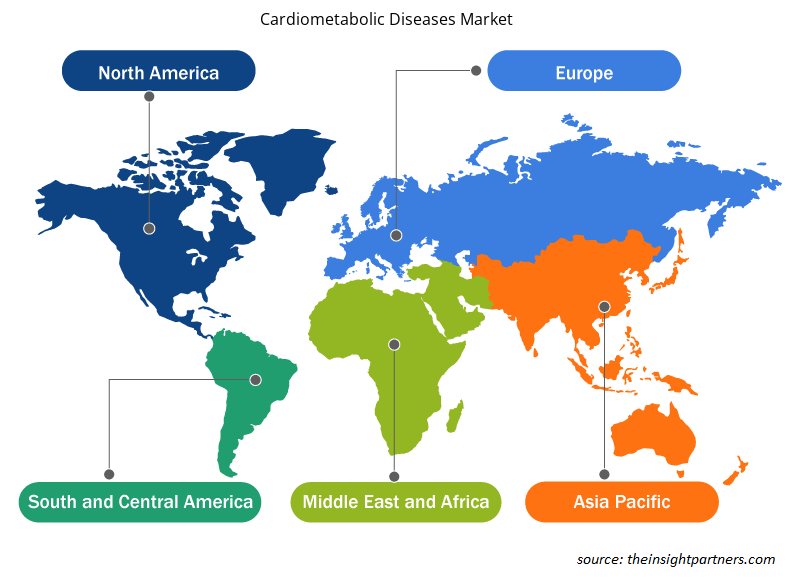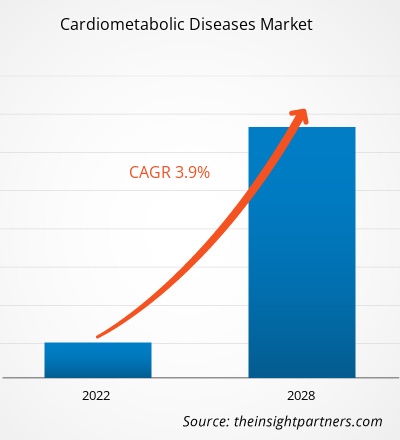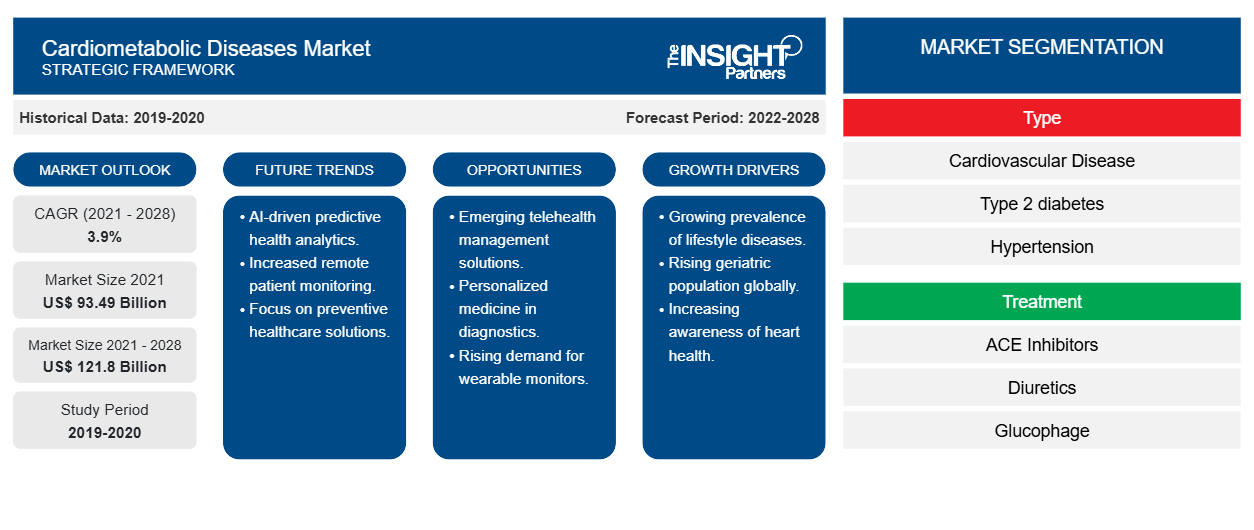Le marché des maladies cardiométaboliques devrait atteindre 121 804,49 millions USD d'ici 2028, contre 93 494,41 millions USD en 2021 ; il devrait croître à un TCAC de 3,9 % au cours de la période 2021-2028.
Les maladies cardiométaboliques sont caractérisées par un ensemble d'anomalies et de symptômes qui augmentent le risque de développer une maladie cardiovasculaire. L'hypertension, l'obésité, la résistance à l'insuline, la dyslipidémie, un mauvais profil de cholestérol (LDL) et une tolérance au glucose sont quelques-uns des symptômes des maladies cardiométaboliques. Les personnes souffrant du syndrome cardiométabolique sont sujettes à de nombreuses autres maladies potentiellement mortelles, telles que le diabète de type 2, les accidents vasculaires cérébraux, les maladies coronariennes (MC) et les maladies cardiovasculaires (MCV). Des conditions génétiques et environnementales sont à la fois responsables du développement de ces maladies.
La croissance du marché des maladies cardiométaboliques est principalement attribuée à des facteurs tels que la prévalence croissante des maladies cardiométaboliques et l’innovation dans les thérapies contre les maladies cardiométaboliques. Cependant, le sous-diagnostic des maladies cardiovasculaires dans les pays à revenu faible et intermédiaire (PRFI) freine la croissance du marché.
Personnalisez ce rapport en fonction de vos besoins
Vous bénéficierez d'une personnalisation gratuite de n'importe quel rapport, y compris de certaines parties de ce rapport, d'une analyse au niveau des pays, d'un pack de données Excel, ainsi que de superbes offres et réductions pour les start-ups et les universités.
-
Obtenez les principales tendances clés du marché de ce rapport.Cet échantillon GRATUIT comprendra une analyse de données, allant des tendances du marché aux estimations et prévisions.
Perspectives du marché
Prévalence croissante des maladies cardiométaboliques
Les maladies cardiométaboliques (MC) sont l’une des principales causes de décès dans le monde. Ces maladies sont principalement causées par un mode de vie malsain, l’inactivité physique, le tabagisme et une alimentation malsaine. Les MMC comprennent les maladies cardiovasculaires (MCV), le diabète sucré et l’insuffisance rénale chronique. Selon l’OMS, environ 17,9 millions de personnes sont décédées de MCV en 2019, ce qui représente 32 % de tous les décès dans le monde. Parmi ces décès, 85 % étaient dus à une crise cardiaque et à un accident vasculaire cérébral.
La plupart des maladies cardiovasculaires peuvent être évitées en s’attaquant aux facteurs de risque comportementaux, tels que le tabagisme, les choix alimentaires malsains, l’obésité, l’inactivité physique et la consommation d’alcool. Le diabète est l’une des maladies chroniques potentiellement mortelles pour lesquelles il n’existe aucun traitement curatif fonctionnel. Il entraîne diverses complications et augmente le risque global de décès prématuré. Les principales complications associées au diabète sont les crises cardiaques, les accidents vasculaires cérébraux, l’insuffisance rénale, l’amputation des jambes, la perte de la vision et les lésions nerveuses. Selon la Fédération internationale du diabète (FID), en 2019, environ 463 millions d’adultes vivaient avec le diabète, un chiffre qui devrait atteindre 700 millions d’ici 2045.
Le nombre de personnes atteintes d'une ou plusieurs maladies cardio-vasculaires est en augmentation dans le monde en raison de l'augmentation du tabagisme, du manque d'exercice, de la consommation d'alcool et des habitudes alimentaires malsaines. Selon les statistiques de l'OMS de juillet 2021, plus de 8 millions de personnes meurent chaque année à cause de la consommation de tabac. Sa consommation est plus élevée dans les pays à revenu faible et intermédiaire, 80 % de sa base de consommateurs mondiale vivant dans ces pays. La prévalence croissante de l'obésité fait également augmenter la base de patients souffrant de maladies cardio-vasculaires. Avec cette augmentation rapide de la prévalence des maladies cardio-vasculaires, le besoin de traitements appropriés contre les maladies cardio-métaboliques a explosé, entraînant une croissance considérable du marché.
Informations basées sur les types
Le marché des maladies cardiométaboliques, par type, est segmenté en maladies cardiovasculaires (MCV), hypertension, diabète de type 2 et obésité. Le segment des maladies cardiovasculaires (MCV) détenait la plus grande part du marché en 2021, et le segment devrait enregistrer le TCAC le plus élevé du marché au cours de la période de prévision.
Informations basées sur le traitement
En termes de traitement, le marché des maladies cardiométaboliques est segmenté en inhibiteurs de l'ECA, diurétiques, Glucophage et autres. Le segment des inhibiteurs de l'ECA détenait la plus grande part du marché en 2021, et le même segment devrait enregistrer le TCAC le plus élevé du marché au cours de la période de prévision.
Informations basées sur le dosage
Le marché des maladies cardiométaboliques, par dosage, est divisé en comprimés et en injections. Le segment des comprimés détenait une part de marché plus importante en 2021 et devrait enregistrer un TCAC plus élevé sur le marché au cours de la période de prévision.
Informations basées sur la voie d'administration
Le marché des maladies cardiométaboliques, par voie d'administration, est divisé en deux parties : orale et intraveineuse. En 2021, le segment oral détenait une part de marché plus importante et devrait enregistrer un TCAC plus élevé dans les années à venir.
Informations basées sur les utilisateurs finaux
Le marché des maladies cardiométaboliques, par utilisateurs finaux, est segmenté en milieu clinique, hospitalier et de soins à domicile. En 2021, le segment hospitalier détenait la plus grande part du marché et devrait enregistrer le TCAC le plus élevé du marché au cours de la période de prévision.
Les lancements et les approbations de produits sont des stratégies couramment adoptées par les entreprises pour étendre leur présence mondiale et leurs portefeuilles de produits. De plus, les acteurs du marché test développés en laboratoire se concentrent sur la stratégie de partenariat pour élargir leur clientèle, ce qui, à son tour, leur permet de maintenir leur nom de marque à l'échelle mondiale.
Le rapport segmente le marché des maladies cardiométaboliques comme suitcardiometabolic diseases market as follows
Français En fonction du type, le marché des maladies cardiométaboliques est segmenté en maladies cardiovasculaires (MCV), hypertension, diabète de type 2 et obésité. En fonction du traitement, le marché est segmenté en inhibiteurs de l'ECA, diurétiques, Glucophage et autres. En fonction du dosage, le marché des maladies cardiométaboliques est divisé en comprimés et injections. En fonction de la voie d'administration, le marché est divisé en voie orale et intraveineuse. En fonction des utilisateurs finaux, le marché des maladies cardiométaboliques est segmenté en clinique, hôpital et soins à domicile. Par géographie, le marché est segmenté en Amérique du Nord (États-Unis, Canada et Mexique), Europe (Royaume-Uni, Allemagne, France, Italie, Espagne et reste de l'Europe), Asie-Pacifique (Chine, Japon, Inde, Australie, Corée du Sud et reste de l'Asie-Pacifique), Moyen-Orient et Afrique (Émirats arabes unis, Arabie saoudite, Afrique du Sud et reste du Moyen-Orient et de l'Afrique), et Amérique du Sud et centrale (Brésil, Argentine et reste de l'Amérique du Sud et centrale).cardiometabolic diseases market is segmented into cardiovascular disease (CVD), hypertension, type 2 diabetes, and obesity. Based on treatment, the market is segmented into ACE inhibitors, diuretics, Glucophage, and others. Based on dosage, the cardiometabolic diseases market is bifurcated into tablet and injection. Based on route of administration, the market is bifurcated into oral and intravenous. Based on end users, the cardiometabolic diseases market is segmented into clinic, hospital, and homecare setting. By geography, the market is segmented into North America (the US, Canada, and Mexico), Europe (the UK, Germany, France, Italy, Spain, and the Rest of Europe), Asia Pacific (China, Japan, India, Australia, South Korea, and the Rest of Asia Pacific), the Middle East and Africa (the UAE, Saudi Arabia, South Africa, and the Rest of the Middle East and Africa), and South and Central America (Brazil, Argentina, and the Rest of South and Central America).
Aperçu régional du marché des maladies cardiométaboliques Diseases Market Regional Insights
Les tendances régionales et les facteurs influençant le marché des maladies cardiométaboliques tout au long de la période de prévision ont été expliqués en détail par les analystes d’Insight Partners. Cette section traite également des segments et de la géographie du marché des maladies cardiométaboliques en Amérique du Nord, en Europe, en Asie-Pacifique, au Moyen-Orient et en Afrique, ainsi qu’en Amérique du Sud et en Amérique centrale.Cardiometabolic Diseases Market throughout the forecast period have been thoroughly explained by the analysts at Insight Partners. This section also discusses Cardiometabolic Diseases Market segments and geography across North America, Europe, Asia Pacific, Middle East and Africa, and South and Central America.

- Obtenez les données régionales spécifiques au marché des maladies cardiométaboliques
Portée du rapport sur le marché des maladies cardiométaboliques
| Attribut de rapport | Détails |
|---|---|
| Taille du marché en 2021 | 93,49 milliards de dollars américains |
| Taille du marché d'ici 2028 | 121,8 milliards de dollars américains |
| Taux de croissance annuel moyen mondial (2021-2028) | 3,9% |
| Données historiques | 2019-2020 |
| Période de prévision | 2022-2028 |
| Segments couverts |
Par type
|
| Régions et pays couverts |
Amérique du Nord
|
| Leaders du marché et profils d'entreprises clés |
|
Densité des acteurs du marché : comprendre son impact sur la dynamique des entreprises
Le marché des maladies cardiométaboliques connaît une croissance rapide, tirée par la demande croissante des utilisateurs finaux en raison de facteurs tels que l'évolution des préférences des consommateurs, les avancées technologiques et une plus grande sensibilisation aux avantages du produit. À mesure que la demande augmente, les entreprises élargissent leurs offres, innovent pour répondre aux besoins des consommateurs et capitalisent sur les tendances émergentes, ce qui alimente davantage la croissance du marché.
La densité des acteurs du marché fait référence à la répartition des entreprises ou des sociétés opérant sur un marché ou un secteur particulier. Elle indique le nombre de concurrents (acteurs du marché) présents sur un marché donné par rapport à sa taille ou à sa valeur marchande totale.
Les principales entreprises opérant sur le marché des maladies cardiométaboliques sont :
- Eli Lilly et compagnie
- Bayer AG
- Arrowhead Pharmaceuticals, Inc
- Novartis SA
- Boehringer Ingelheim International GmbH
Avis de non-responsabilité : les sociétés répertoriées ci-dessus ne sont pas classées dans un ordre particulier.

- Obtenez un aperçu des principaux acteurs du marché des maladies cardiométaboliques
Profils d'entreprise
- Eli Lilly et compagnie
- Bayer AG
- Arrowhead Pharmaceuticals, Inc
- Novartis SA
- Boehringer Ingelheim International GmbH
- Novo Nordisk A/S
- AstraZeneca
- Alnylam Pharmaceuticals, Inc.
- Cardax, Inc
- Société Kowa, Ltd.
- Analyse historique (2 ans), année de base, prévision (7 ans) avec TCAC
- Analyse PEST et SWOT
- Taille du marché Valeur / Volume - Mondial, Régional, Pays
- Industrie et paysage concurrentiel
- Ensemble de données Excel
Rapports récents
Témoignages
Raison d'acheter
- Prise de décision éclairée
- Compréhension de la dynamique du marché
- Analyse concurrentielle
- Connaissances clients
- Prévisions de marché
- Atténuation des risques
- Planification stratégique
- Justification des investissements
- Identification des marchés émergents
- Amélioration des stratégies marketing
- Amélioration de l'efficacité opérationnelle
- Alignement sur les tendances réglementaires























 Obtenez un échantillon gratuit pour - Marché des maladies cardiométaboliques
Obtenez un échantillon gratuit pour - Marché des maladies cardiométaboliques